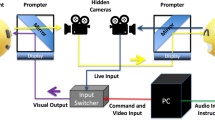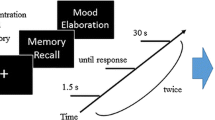Abstract
Women were videotaped while they spoke about a positive and a negative experience either in the presence of an experimenter or alone. They gave self-reports of their emotional experience, and the videotapes were rated for facial and verbal expression of emotion. Participants spoke less about their emotions when the experimenter (E) was present. When E was present, during positive disclosures they smiled more, but in negative disclosures they showed less negative and more positive expression. Facial behavior was only related to experienced emotion during positive disclosure when alone. Verbal behavior was related to experienced emotion for positive and negative disclosures when alone. These results show that verbal and nonverbal behaviors, and their relationship with emotional experience, depend on the type of emotion, the nature of the emotional event, and the social context.
Similar content being viewed by others
References
Andrus, T. D. (1946). A study of laugh patterns in the theater. Speech Monographs, 13, 114.
APA (1992). Ethical principles of psychologists and code of conduct. Washington, DC: American Psychological Association.
Bainum, C. K., Lounsbury, K. R., & Pollio, H. R. (1984). The development of laughing and smiling in nursery school children. Child Development, 55, 1946-1957.
BPS (2000). Code of conduct, ethical principles, and guidelines. Leicester: British Psychological Society.
Buck, R. (1984). The communication of emotion. New York: Guilford Press.
Buck, R., Losow, J. I., Murphy, M., & Costanzo, P. (1992). Social facilitation and inhibition of emotional expression and communication. Journal of Personality and Social Psychology, 63, 962-968.
Buck, R., Miller, R. E., & Caul, W. F. (1974). Sex, personality and physiological variables in the communication of emotion via facial expression. Journal of Personality and Social Psychology, 23, 362-371.
Buck, R., Savin, V. J., Miller, R. E, & Caul, W. F. (1972). Nonverbal communication of affect in humans. Journal of Personality and Social Psychology, 30, 125-133.
Chapman, A. J. (1973). Social facilitation of laughter in children. Journal of Experimental Social Psychology, 9, 528-541.
Chapman, A. J. (1975). Humorous laughter in children. Journal of Personality and Social Psychology, 31, 42-49.
Chapman, A. J., & Wright, D. S. (1976). Social enhancement of laughter: an experimental analysis of some companion variables. Journal of Experimental Child Psychology, 21, 201-218.
DePaulo, B. M., Blank, A. L., Swaim, G. W., & Hairfield, J. G. (1992). Expressiveness and expressive control. Personality and Social Psychology Bulletin, 18, 276-285.
Ekman, P. (1972). Universal and cultural differences in facial expressions of emotion. In J. K. Cole (Ed.), Nebraska symposium on motivation, 1971 (pp. 207-283). Lincoln: University of Nebraska Press.
Ekman, P. (1989). The argument and evidence about universals in facial expressions of emotion. In H. Wagner & A. Manstead (Eds.), Handbook of social psychophysiology (pp. 143-164). Chichester/New York: Wiley.
Ekman, P., & Friesen, W. V. (1978). Facial action coding system: A technique for the measurement of facial movement. Palo Alto, CA: Consulting Psychologists Press.
Ekman, P., Friesen, W. V., & Ancoli, S. (1980). Facial signs of emotional experience. Journal of Personality and Social Psychology, 39, 1125-1134.
Fernández-Dols, J. M., & Ruiz-Belda, M. A. (1995). Are smiles a sign of happiness? Gold medal winners at the Olympic Games. Journal of Personality and Social Psychology, 69, 1113-1119.
Fernández-Dols, J. M., Sánchez, F., Carrera, P., & Ruiz-Belda, M. A. (1997). Are spontaneous expressions and emotions linked? An experimental test of coherence. Journal of Nonverbal Behavior, 21 (3), 163-177.
Fridlund, A. J. (1991). Sociality of solitary smiling: Potentiation by an implicit audience. Journal of Personality and Social Psychology, 60, 229-240.
Fridlund, A. J. (1994). Human facial expression: An evolutionary view. San Diego, CA: Academic Press.
Fridlund, A. J., Kenworthy, K. G., & Jaffey, A. K. (1992). Audience effects I affective imagery: Replication and extension to dysphoric imagery. Journal of Nonverbal Behavior, 16, 191-211.
Friedman, H. S., Prince, L. M., Riggio, R. E., & DiMatteo, M. R. (1980). Understanding and assessing nonverbal expressiveness: The Affective Communication Test. Journal of Personality and Social Psychology, 39, 333-351.
Friesen, W. V. (1972). Cultural differences in facial expressions in a social situation: An experimental test of the concept of display rules. Unpublished doctoral dissertation, University of California, San Francisco.
Gross, J. J., & Levenson, R. W. (1993). Emotional suppression: Physiology, self-report and expressive behavior. Journal of Personality and Social Psychology, 64(6), 970-986.
Halberstadt, A. G., Crisp, V. W., & Eaton, K. L. (1999). Family expressiveness: A retrospective and new directions approach. In P. Philippot, R. S. Feldman & E. J. Coats (Eds.), The social context of nonverbal behavior (pp. 109-155). Cambridge: Cambridge University Press.
Izard, C. E. (1991). The psychology of emotions. New York: Plenum.
Jakobs, E., Manstead, A. S. R., & Fischer, A. H. (1996). Sociality effects on facial displays of sadness: Friends versus strangers. Poster presented at the XIth General Meeting of the European Association for Experimental Social Psychology, Gmunden, Austria.
Jakobs, E., Manstead, A. S. R., & Fischer, A. H. (1999). Social motives and subjective feelings as determinants of facial displays: the case of smiling. Personality and Social Psychology Bulletin, 25, 424-435.
Kilbride, J. E., & Yarczower, M. (1980). Recognition and imitation of facial expressions: A cross-cultural comparison between Zambia and the United States. Journal of Cross-Cultural Psychology, 11, 281-296.
Kilbride, J. E., & Yarczower, M. (1983). Ethnic bias in the recognition of facial expressions. Journal of Nonverbal Behavior, 8, 27-41.
Kleck, R. E., Vaughan, R. C., Cartwright-Smith, J., Vaughan, K. B., Colby, C. Z., & Lanzetta, J. T. (1976). Effects of being observed on expressive, subjective and physiological responses to pain stimuli. Journal of Personality and Social Psychology, 34, 1211-1218.
Kraut, R. E. (1982). Social presence, facial feedback, and emotion Journal of Personality and Social Psychology, 42, 853-863.
Kraut, R. E., & Johnston, R. E. (1979). Social and emotional messages of smiling: An ethological approach. Journal of Personality and Social Psychology, 37, 1539-1553.
Lee, V., & Beattie, G. (1998). The rhetorical organization of verbal and nonverbal behavior in emotion talk. Semiotica, 120, 39-92.
Malatesta, C. Z., Jonas, R., & Izard, C. E. (1987). The relation between low facial expressivity during emotional arousal and somatic symptoms. British Journal of Medical Psychology, 60, 169-180.
Manstead, A. S. R. (1991). Expressiveness as an individual difference. In R. S. Feldman and B. Rimé (Eds.), Fundamentals of nonverbal behavior (pp. 329-350). Cambridge: Cambridge University Press.
Manstead, A. S. R., Fischer, A. F., & Jakobs, E. (1999). The social and emotional functions of facial displays. In P. Philippot, R. S. Feldman & E. J. Coats (Eds.), The Social Context of Nonverbal Behavior (pp. 287-313). Cambridge: Cambridge University Press.
McDonald, P. W., & Prkachin, K. M. (1990). The expression and perception of facial emotion in alexithymia: A pilot study. Psychosomatic Medicine, 52, 199-210.
Nichols, M. P., & Zax, M. (1977). Catharsis in psychotherapy. New York: Gardner Press.
Pennebaker, J. W., & O'Heeron, R. C. (1984). Confiding in others and illness among spouses of suicide and accidental death victims. Journal of Abnormal Psychology, 93, 473-476.
Rosenberg, E. L., & Ekman, P. (1994). Coherence between expressive and experiential systems in emotion. Cognition and Emotion, 8, 201-229.
Rosenthal, R. (1982). Conducting judgment studies. In K. R. Scherer & P. Ekman (Eds.), Handbook of methods in nonverbal behavior research (pp. 287-361). Cambridge: Cambridge University Press.
Wagner, H. L., & Lee, V. (1999). Facial behavior alone and in the presence of others. In P. Philippot, R. S. Feldman & E. J. Coats (Eds.), The social context of nonverbal behavior (pp. 262-286). Cambridge: Cambridge University Press.
Wagner, H. L., Lewis, H., Ramsay, S., & Krediet, I. (1992). Prediction of facial displays from knowledge of norms of emotional expressiveness. Motivation and Emotion, 16, 347-362.
Wagner, H. L., MacDonald, C. J., & Manstead, A. S. R. (1986). Communication of individual emotions by spontaneous facial expression. Journal of Personality and Social Psychology, 50, 737-743.
Wagner, H. L., & Smith, J. (1991). Facial expressions in the presence of friends and strangers. Journal of Nonverbal Behavior, 15, 201-214.
Yarczower, M., Kilbride, J. E., & Hill, L. A. (1979). Imitation and inhibition of facial expressions. Developmental Psychology, 15, 453-454.
Young, R. D., & Fry, M. (1966). Some are laughing; some are not-why? Psychological Reports, 18, 747-754.
Author information
Authors and Affiliations
Corresponding author
Rights and permissions
About this article
Cite this article
Lee, V., Wagner, H. The Effect of Social Presence on the Facial and Verbal Expression of Emotion and the Interrelationships Among Emotion Components. Journal of Nonverbal Behavior 26, 3–25 (2002). https://doi.org/10.1023/A:1014479919684
Issue Date:
DOI: https://doi.org/10.1023/A:1014479919684




